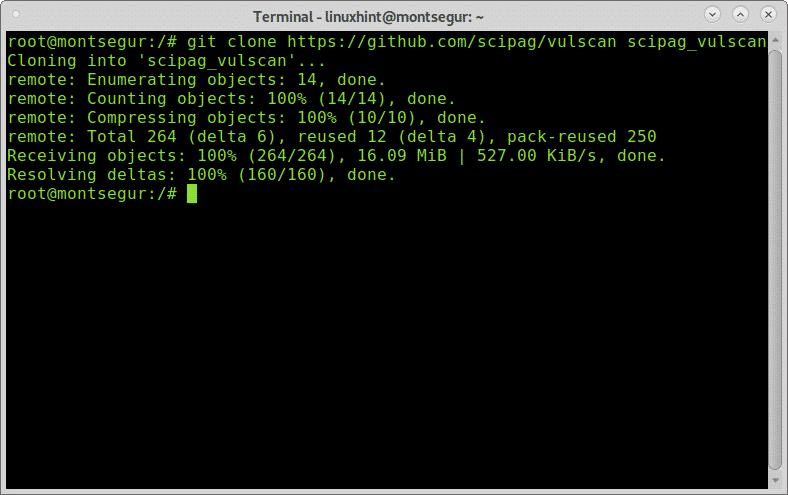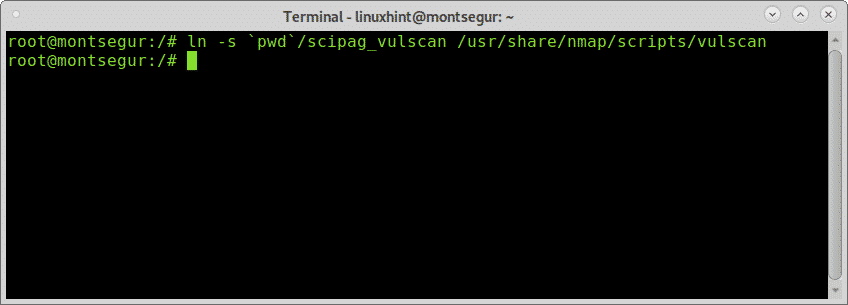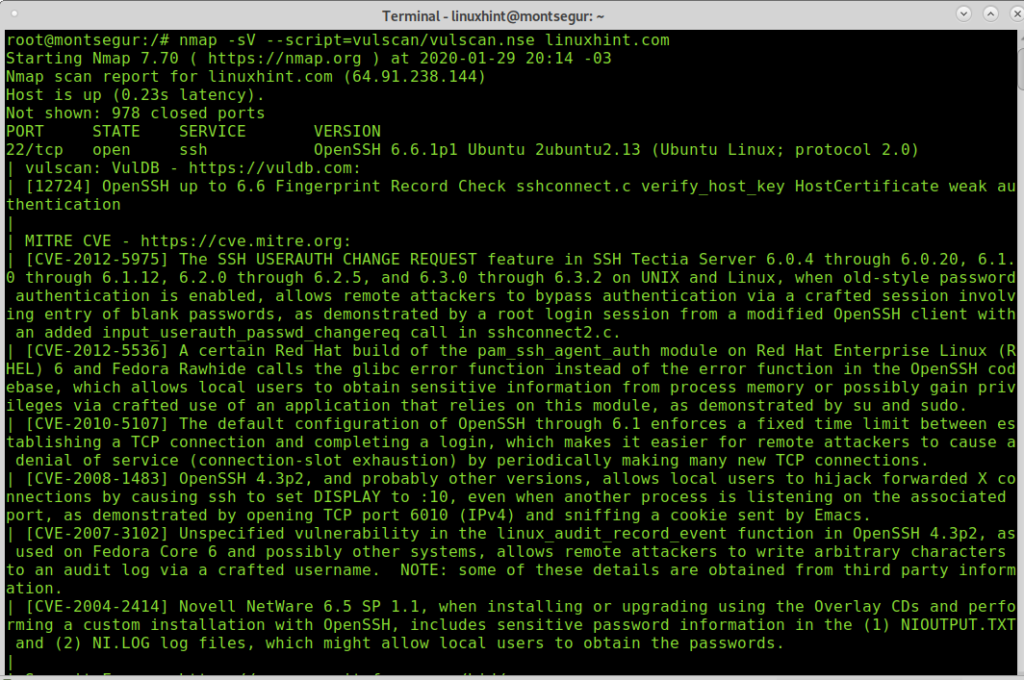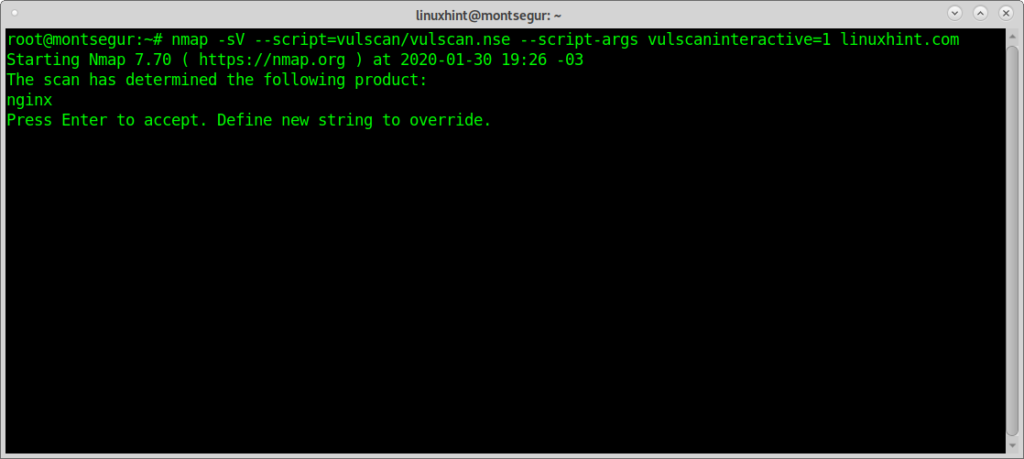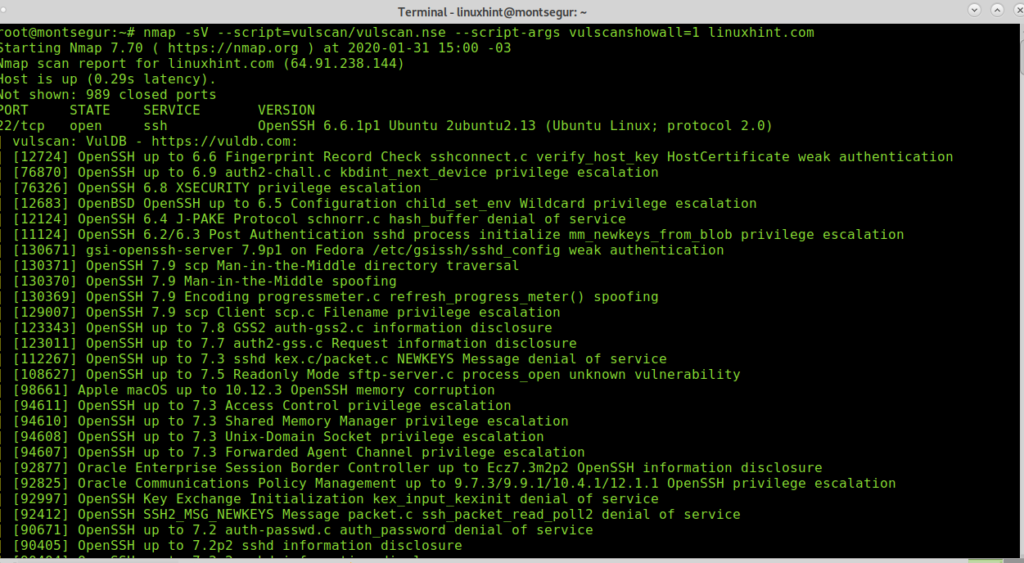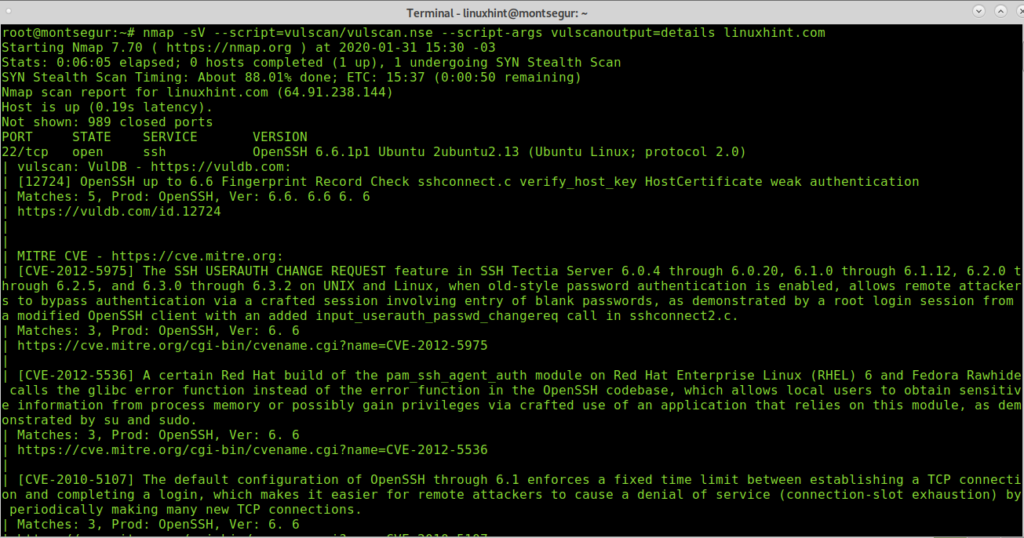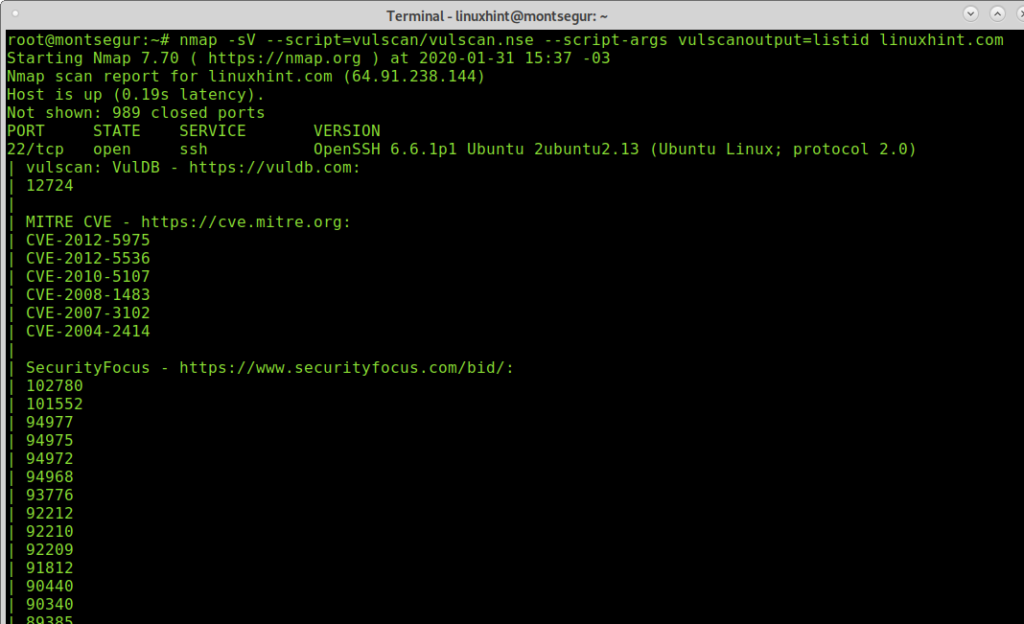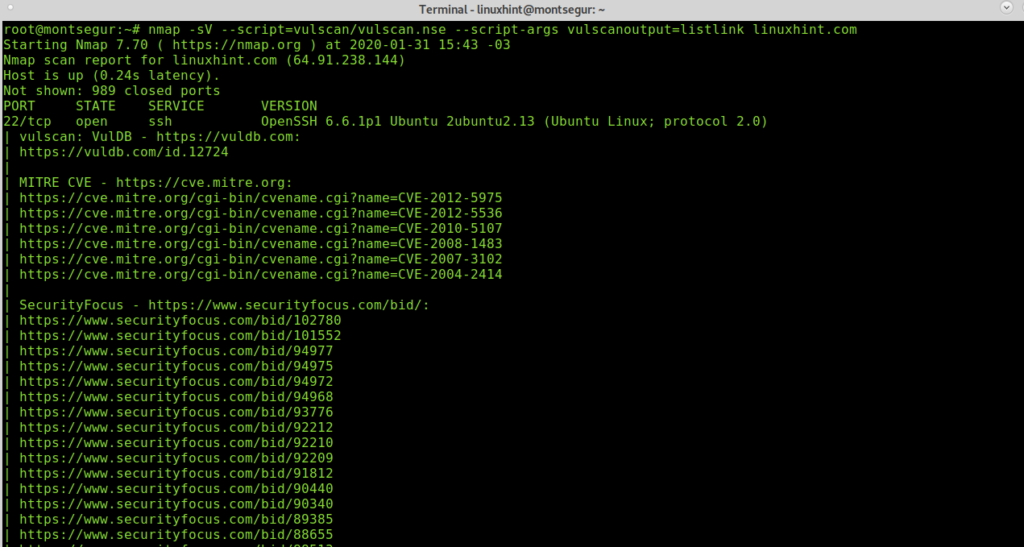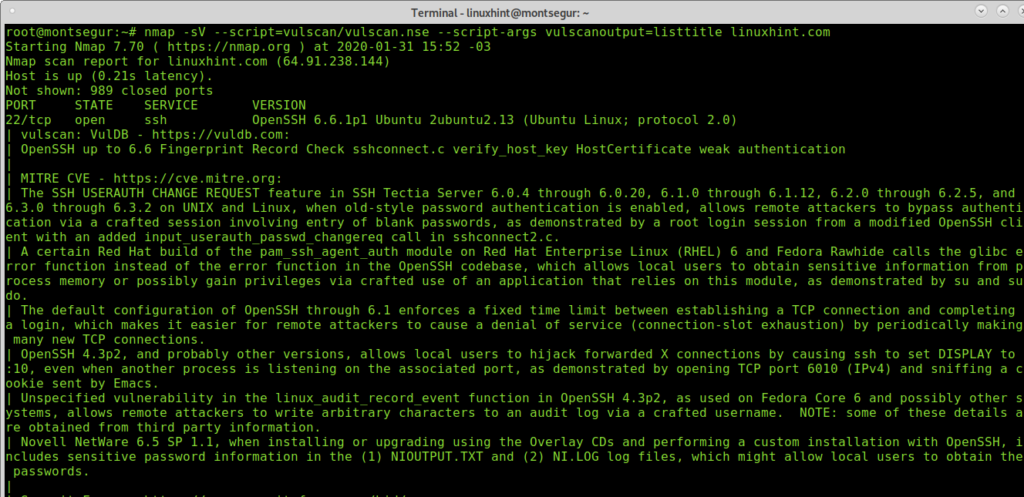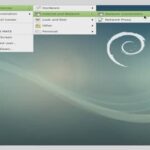This tutorial shows how to install and carry out a scan using vuls script. Vuls results tend to show long list of possible vulnerabilities, one per script it will run against each service detected in the target.
To begin installing Vulscan using git, run:
Note: you can install git by running apt install git
Then run:
To begin with a minimal scan run:
Analyzing the Vulscan output:
The first lines will show the characteristics of the scan, such as Nmap version, timing, and previous info on the target such as its state.
# nmap -sV --script=vulscan/vulscan.nse linuxhint.com Starting Nmap 7.70 ( https://nmap.org ) at 2020-01-29 20:14 -03 Nmap scan report for linuxhint.com (64.91.238.144) Host is up (0.23s latency).
Then it will start reporting on available services, contrasting them with vulnerabilities of the Vulscan database, as you can see below, after detecting that the SSH port is available Vulscan starts running scripts to check for vulnerabilities for this specific service:
IMPORTANT NOTE: to keep this tutorial readable 90% of executed scripts for each service were removed, all you need to know is all possible vulnerabilities for a specific service existing in the database will be checked.
Not shown: 978 closed ports PORT STATE SERVICE VERSION 22/tcp open ssh OpenSSH 6.6.1p1 Ubuntu 2ubuntu2.13 (Ubuntu Linux; protocol 2.0) | vulscan: VulDB - https://vuldb.com: | [12724] OpenSSH up to 6.6 Fingerprint Record Check sshconnect.c verify_host_key HostCertificate weak authentication | | MITRE CVE - https://cve.mitre.org: | [CVE-2012-5975] The SSH USERAUTH CHANGE REQUEST feature in SSH Tectia Server 6.0.4 through 6.0.20, 6.1.0 through 6.1.12, 6.2.0 through 6.2.5, and 6.3.0 through 6.3.2 on UNIX and Linux, when old-style password authentication is enabled, allows remote attackers to bypass authentication via a crafted session involving entry of blank passwords, as demonstrated by a root login session from a modified OpenSSH client with an added input_userauth_passwd_changereq call in sshconnect2.c. | [CVE-2012-5536] A certain Red Hat build of the pam_ssh_agent_auth module on Red Hat Enterprise Linux (RHEL) 6 and Fedora Rawhide calls the glibc error function instead of the error function in the OpenSSH codebase, which allows local users to obtain sensitive information from process memory or possibly gain privileges via crafted use of an application that relies on this module, as demonstrated by su and sudo. | [CVE-2010-5107] The default configuration of OpenSSH through 6.1 enforces a fixed time limit between establishing a TCP connection and completing a login, which makes it easier for remote attackers to cause a denial of service (connection-slot exhaustion) by periodically making many new TCP connections. | [CVE-2008-1483] OpenSSH 4.3p2, and probably other versions, allows local users to hijack forwarded X connections by causing ssh to set DISPLAY to :10, even when another process is listening on the associated port, as demonstrated by opening TCP port 6010 (IPv4) and sniffing a cookie sent by Emacs.
Below you see the port 25 is filtered, probably by a firewall or Vuls is unable to determine its state with security. It then checks for the port 80 finding it open and detecting Nginx behind it and again, like with OpenSSH detected previously, Vuls will run tests to confirm or discard all vulnerabilities contained in the database.
IMPORTANT NOTE: to keep this tutorial readable 90% of executed scripts for each service were removed, all you need to know is all possible vulnerabilities for a specific service existing in the database will be checked.
25/tcp filtered smtp 80/tcp open http nginx |_http-server-header: nginx | vulscan: VulDB - https://vuldb.com: | [133852] Sangfor Sundray WLAN Controller up to 3.7.4.2 Cookie Header nginx_webconsole.php Code Execution | [132132] SoftNAS Cloud 4.2.0/4.2.1 Nginx privilege escalation | [131858] Puppet Discovery up to 1.3.x Nginx Container weak authentication | [130644] Nginx Unit up to 1.7.0 Router Process Request Heap-based memory corruption | [127759] VeryNginx 0.3.3 Web Application Firewall privilege escalation | [126525] nginx up to 1.14.0/1.15.5 ngx_http_mp4_module Loop denial of service | [126524] nginx up to 1.14.0/1.15.5 HTTP2 CPU Exhaustion denial of service | [126523] nginx up to 1.14.0/1.15.5 HTTP2 Memory Consumption denial of service | [119845] Pivotal Operations Manager up to 2.0.13/2.1.5 Nginx privilege escalation | [114368] SuSE Portus 2.3 Nginx Certificate weak authentication | [103517] nginx up to 1.13.2 Range Filter Request Integer Overflow memory corruption
Finally, Nmap will show all filtered ports found:
|_ 1666/tcp filtered netview-aix-6 2000/tcp filtered cisco-sccp 2001/tcp filtered dc 2002/tcp filtered globe 2003/tcp filtered finger 2004/tcp filtered mailbox 2005/tcp filtered deslogin 2006/tcp filtered invokator 2007/tcp filtered dectalk 2008/tcp filtered conf 2009/tcp filtered news 2010/tcp filtered search 6666/tcp filtered irc 6667/tcp filtered irc 6668/tcp filtered irc 6669/tcp filtered irc 9100/tcp filtered jetdirect Service Info: OS: Linux; CPE: cpe:/o:linux:linux_kernel Service detection performed. Please report any incorrect results at https://nmap.org/submit/ . Nmap done: 1 IP address (1 host up) scanned in 632.44 seconds
From the scan above we understand the process is to find available services to then run tests for all known vulnerabilities for the service detected, contained in Vuls vulnerabilities database.
You can allow Nmap version detection while omitting Vuls version detection by adding the flag –script-args vulscanversiondetection=0.
linuxhint.com
Vulscan allows you launch interactive scans in which you are allowed to determine if a specific service must be scanned for vulnerabilities, to achieve it you need to apply the option –script-args vulscaninteractive=1.
On the console run:
The scan will halt to ask you if it should proceed checking vulnerabilities for Nginx:
The argument vulscanshowall allows to print results according to accuracy, the lower value will print all results, while increasing the value results will get reduced to better matches.
The following options allow to determine the format in which Nmap will show the output, the option vulscanoutput=details enables the most descriptive output, by running it Nmap will show additional information for each script.
The listid option will print the results as a list of vulnerabilities identified by their ID.
The option listlink prints a list of links to the vulnerabilities database with additional information on each one.
Finishing with output formats, the option listtitle will print a list of vulnerabilities by name.
Finally, to end this tutorial keep in mind for Vuls to give the best you must seek the databases to remain up to date. To update Vuls databases always download the last version of the files in the following urls and keep them saved on Vuls main directory (where databases with same names are already stored in):
- https://www.computec.ch/projekte/vulscan/download/cve.csv
- https://www.computec.ch/projekte/vulscan/download/exploitdb.csv
- https://www.computec.ch/projekte/vulscan/download/openvas.csv
- https://www.computec.ch/projekte/vulscan/download/osvdb.csv
- https://www.computec.ch/projekte/vulscan/download/scipvuldb.csv
- https://www.computec.ch/projekte/vulscan/download/securityfocus.csv
- https://www.computec.ch/projekte/vulscan/download/securitytracker.csv
- https://www.computec.ch/projekte/vulscan/download/xforce.csv
I hope you found this tutorial on how to use Nmap Vulscan useful, keep following LinuxHint for more tips and updates on Linux.

